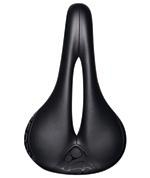
Figuring out what is the right bicycle saddle height makes all the difference
Bike riding is a superb form of exercise and fun, too, but if the saddle (the seat) on the bike isn?t properly adjusted you are going to be uncomfortable and may end up suffering from aches and pains the next day. It is extremely important that you position the bike saddle at the right height. This prevents injuries.
So what is the right bicycle saddle height for you? You may have to experiment.
The right height and positioning of a bicycle saddle allow you to move around on the seat when you need to, and enables the saddle to fully support your body weight. If the seat is angled so that it tilts too far forward this is going to put too much pressure on certain parts of your body.
If the saddle has a downward tilt, you may well slide forward when you are cycling and this puts added stress on your hands, arms and knees, which can result in an injury.
When the seat is too high, you will find your pelvic rocking from side to side as you pedal and this puts pressure on your perineum every time you pedal. When a seat tilts forward you slide forward while cycling. When you slide forward the sit bones can no longer provide support for your pelvis. The nose of the saddle presses on the perineum and this isn?t comfortable.
When the seat is too low, this is going to make your knees bend too much when pedaling. You can harm your knees. Additionally, when the saddle is positioned too low, you sit with more weight on the seat because it is harder to carry the weight of your legs. This is uncomfortable. If the seat is too high, you may keep moving forward on the seat and end up riding on the front, narrow part of the saddle.
~
When you are choosing a seat for your bike choose one that accommodates your individual anatomy.
If you are a big man and have a wide pelvis the saddle needs to have a wide rear sitting area. If you are a smaller person, you want a saddle that is narrower. There is a device that can be used to measure your sit-bone width. The right saddle reduces pressure in the area between your legs, which is the perineum, and supports your sit bones.
A seat can be adjusted so that it is moved more to the front (fore) or to the back (aft) position. You will get saddle sores if your seat doesn?t fit your buttocks correctly, or it isn?t positioned correctly. Knee pain can be caused by a seat that is too low or too high or that is situated too far back or too far to the front. A high seat will also cause pain in the backs of your knees. When a seat is positioned too far forward or is too low, this can cause pain in the fronts of your knees.
The width of the back of the seat should be as wide as the distance between your sit bones. Lie on your back and elevate your knees. Using a straight ruler, place the end of at the outside edge of your ischial tuberosity (pelvic bone) and then measure how far it is to the right outside edge of the other ischial tuberosity.
Adjust the seat by loosening the pinch bolt and then raising or lowering the seat to the proper height. Re-tighten the bolt. Sit on the bike and put your foot on top of the pedal spindle when the crank is at the bottom of its rotation. Is your leg slightly bent? It should be. If it is extremely bent, this means that you need to raise the seat. If your leg is absolutely straight, you need to lower the post. You can also check to see if the seat height is correct by putting the heel of your foot over the pedal spindle. When you do this, your leg should be completely straight.
If you aren?t sure that you have placed the saddle in the proper position raise the saddle by half an inch and see if you are more comfortable. When you raise the seat, your bike is going to feel like it?s going faster and also feels lighter. Raise the seat another half inch and see if that feels better. If you get the seat too high you are going to know it. Lower it again. Your hips will rock from side to side when pedaling if the seat is too high. You may also feel as though you have to stretch your legs to be able to reach the bottom part of the pedal.
Some cyclists prefer padded saddles. They tend to be wider, which can result in chafed thighs. A passed saddle can well up in the center right at the crotch area, putting too much pressure on this area of your body. A narrow and firmer seat supports your sit bones better.
If you are wearing biking shorts that are heavily padded this can cause discomfort due to friction. It may be more comfortable for you to wear biking shorts that have a well-lubricated and thin liner, which reduces friction.
